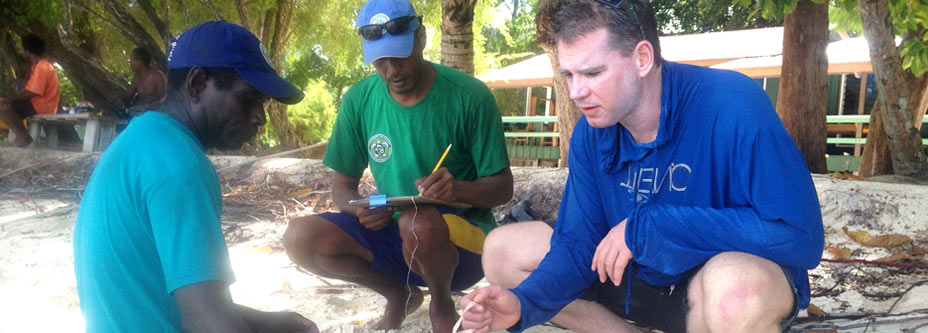
Saving the seas
Otago alumnus Dr Richard Hamilton is combining science with local knowledge to provide a holistic approach to conservation.
It’ s a busy day for marine scientist Dr Richard Hamilton. A media release has gone out about his recent research findings and, as a result, the phone is ringing more frequently than usual for a man who spends much of his time in some of the more remote corners of Melanesia.
Hamilton has uncovered an irrefutable link between logging in the Solomon Islands and a decline in the fish stocks in nearby reefs. It’ s a cautionary tale of ecosystem interdependence that we must now consider alongside the much simpler – though no less important – story of overfishing.
"We cannot view reefs, fish or forests as separate entities," warns Hamilton. "These systems are all connected and this research underscores just how important a complete ecosystem approach to fisheries management is."
Hamilton is a senior scientist for the Asia Pacific Division of the US-based environmental organisation The Nature Conservancy (TNC). Brisbane-based, he spends eight to 10 weeks a year in the Coral Triangle, the roughly triangular area of marine waters surrounding Indonesia, Malaysia, Papua New Guinea, Philippines, Solomon Islands and Timor Leste that is recognised as the global centre of marine biodiversity. Here his research into reef fisheries has helped gain some quiet, but significant, victories for conservation.
In particular, Hamilton was instrumental in achieving local commitment to a network of ridges-to-reefs protected areas across Choiseul Province in the Solomon Islands – the first of its kind in Melanesia.
He was present at the 2009 inter-tribal gathering where more than 100 chiefs agreed to adopt TNC’ s recommendations to create at least one marine and one terrestrial protected area in each of the province’ s 12 districts. The agreement has now been ratified by provincial law, 20 protected areas have been established and Hamilton says they are seeing "good recovery of marine species".
Choiseul Province, also known as Lauru, has the largest remaining stands of lowland rainforest and more plant and animal species than any other island in the Solomon archipelago. Most of the land remains in tribal ownership and TNC has worked with communities there over the last 10 years, helping them with conservation planning and adapting to climate change.
Hamilton calls this type of work, in which scientific and local knowledge come together, "holistic, stakeholder-driven conservation".
"Stakeholders use their knowledge of customary-owned lands and seas to identify areas they would like to see protected in a process known as participatory mapping. Some of the features identified for protection include sources of freshwater, cultural heritage sites, turtle nesting beaches, important forest areas and fish spawning aggregations."
Hamilton adds that this participatory process has now been extended to include cultural heritage mapping, because identifying where sites of cultural importance coincide with important natural heritage sites can assist with securing “buy-in” to preservation measures.
"If you can identify high cultural as well as natural heritage significance, you've got a pretty good chance of securing protection," he says, citing the example of a leatherback turtle nesting beach that also has an important cultural heritage value.
Beyond these practical considerations, Hamilton also believes that conservation practitioners working in indigenous settings have an ethical responsibility to recognise and respect all the landscape values of the custodians of those places, regardless of whether these values fall outside their core biodiversity business.
In this work he is proud to work alongside his former supervisor, Professor Richard Walter from Otago’ s Department of Anthropology and Archaeology. Although Hamilton is a science major, he approached Professor Walter when he embarked on his master's degree in marine science as he was interested in finding out how subsistence fisheries operate in the Pacific. As a result Walter supervised his master's and doctoral theses.
"He taught me critical thinking, introduced me to social sciences and helped me appreciate the value of local ecological knowledge," says Hamilton, who is equally grateful to Professor Philip Mladenov, who backed the young science graduate for postgraduate study in marine science in spite of his average undergraduate grades.
The master's and doctoral degrees he subsequently completed qualified him for the contract work and then permanent position that followed with The Nature Conservancy. Here Hamilton’ s work has also included crossdisciplinary research into reef-fish larval dispersal in Papua New Guinea, where he grew up. This research, published in Current Biology, demonstrated that reef-fish larval dispersion is limited in distance, which provides support for the theory behind the establishment of marine protected areas. He has also co-produced two films directed by Otago Postgraduate Diploma in Natural History Filmmaking and Communication graduate Jordan Plotsky.
Hamilton’ s future research will involve using ancestral and contemporary genetic studies, turtle-tagging surveys and historical and ethnographic research to understand the extinction risks in iconic marine species such as the giant bumphead parrotfish, humphead wrasse and hawksbill turtle. Effective conservation measures for species such as these, he believes, are possible with a crossdisciplinary approach involving both people and nature."Some people might say that the work people like me do is akin to taking the pulse of a dying patient," says Hamilton, "but I have reason to be optimistic. My goal is to be able to tell my grandkids that I tried my best to make a difference."
For more information about Dr Richard Hamilton’ s work please visit the The Nature Conservancy website.
REBECCA TANSLEY
Photo: Lisa Park